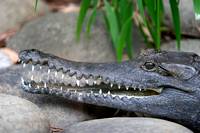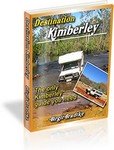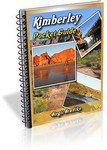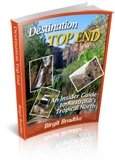Freshwater Crocodiles
Freshwater or Johnston Crocodiles (Crocodylus johnstoni) are common in the Kimberley and across all of northern Australia.
Freshwater Crocodiles live mostly in the upstream areas of rivers and in lakes, swamps and billabongs. They could live in saltwater. The reason that they aren't found in tidal waters is that the bigger and aggressive saltwater crocodiles don't tolerate "Freshies".
That can be good news. A body of water that contains lots of freshwater crocodiles is less likely to be inhabited by a saltwater crocodile. (Though there is no guarantee. One might have just moved in...)
At least the presence of freshwater crocodiles is nothing to worry about. (Even if someone who doesn't know better talks about "crocodile infested waters"... Freshies are harmless.)
A good place to see wild freshwater crocodiles in the Kimberley is Windjana Gorge.
 Freshwater crocodiles are small. Females grow to about 2m, males can reach up to 3m, but it takes them 30 years to reach that size. Most of them are a lot smaller.
Freshwater crocodiles are small. Females grow to about 2m, males can reach up to 3m, but it takes them 30 years to reach that size. Most of them are a lot smaller.
Their maximum weight is about 90kg (compared to over a ton for a saltwater crocodile...)
The head of a freshwater crocodile is very distinctive: small, slender, with a long snout
Freshwater crocodiles breed in the dry season, from July to September. The females dig holes in sandy river banks and lay about a dozen eggs. They don't guard the nest like saltwater crocodiles do, but they do return when the young crocodiles hatch. The also carry their young to the water and keep an eye on them for a while, but nowhere near as long as a saltwater crocodile would.
If the female crocodile is disturbed at all during that period she is likely to abandon her offspring, so please take that into consideration when you see crocodiles during that time of the year. Even without our intervention only 1% of the hatchlings will reach maturity. They are very susceptible to predation and cannibalism is common when food is scarce. There a years where none of the hatchlings survive...
Freshies aren't aggressive, rather shy, but if disturbed during the breeding season or if they feel threatened they may attack. Their teeth are razor sharp and they can inflict serious wounds.
Freshies are mainly fish eaters, but also take a variety of other small animals, whatever they can get hold of...
Freshwater crocodiles are a protected species. Their number is estimated to be at least 100,000. Some farming programs exist for commercial purposes, although their hide is nowhere near as valuable as saltwater crocodile skin. Their populations across Australia are very healthy. The biggest danger freshwater crocodiles will be facing in the future is, as for many other species in this world, habitat destruction...
Travelling to the Kimberley?
 The free Kimberley Pocket Guide
The free Kimberley Pocket Guide
is a great introduction to travel in the region.
The full Kimberley Travel Guide 
shows you how to make the most of your adventure at Australia's last frontier.
Travelling to the Northern Territory?
Destination Top End offers the same comprehensive, detailed insider information for the tropical regions of the Northern Territory.
A must have if you travel to or from Darwin.
NEW! Destination Red Centre is the latest addition in this popular series. Monica Coleman takes you through Australia's red Outback heart, offering all the detail and insider tips that you have come to know and love about our guides. With special emphasis on Aboriginal communities and culture.
A must have if you travel to or from Alice Springs/Uluru.
Read about saltwater crocodiles and how to be crocodile safe in the Kimberley.
Kimberley Australia Travel Guide home page









